Kirby’s – Craft Paint Since 1846
by Mike Crowe
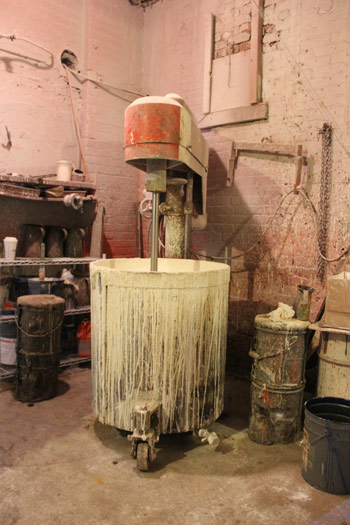
Kirby’s 80-gallon mixing vat. The company has a variety of vats for various custom mixes. An electric motor rotates the shaft and mixing wheel. Fishermen’s Voice photo
In the 1800s, New Bedford was one of the most important—perhaps the most important— whaling ports in the world. Wooden whaling ships and fishing boats lined both the New Bedford and Fairhaven sides of the harbor.
When the whaling ship Charles Morgan was being built at the Hillman shipyard at New Bedford in 1841, George Kirby had not yet developed his new formula for marine bottom and topsides paints. His company would have those paints for sale when it opened on the New Bedford waterfront in 1846. There is a good chance that the reputation of Kirby’s new paint would have made it a candidate for use on the Charles Morgan when it returned in need of paint from its second 3-year whaling trip in 1847.
One hundred and seventy-one years later, George Kirby IV is still making paint in New Bedford, using the same formulas his ancestors developed—formulas that to this day remain confidential. The Kirby paint-making process remains the same and most of the ingredients are the same. When the Kirby Paint building down at the end of Union Street on the waterfront burned on April 1, 1887, the company rebuilt on the same site. G. Kirby, Jr. sent a letter to his customers announcing the reopening and all the products and services that were available. He ended the letter with, “everything is new and improved, except the management.” Along with the paint formulas the family’s philosophical sense of humor has been passed on as well.
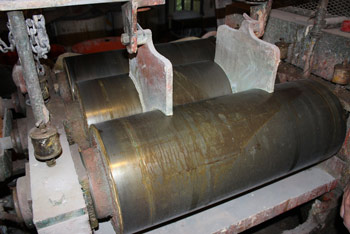
Three mill pigment grinder. Dry color pigments are crushed to a powder between the solid steel rollers. Kirby formerly used this pigment grinder for milling white lead paste. Pigment is placed between the two vertical containment boards, center. Fishermen’s Voice photo
The company would grow to be a major supplier of marine and house paints, with customers as far north as New Brunswick, Canada, and as far west as California and Alaska. When the “urban renewal” era of the 1960s forced Kirby Paint out of its waterfront home of 123 years to make way for a new highway, a road which eventually separated the fishing town from its waterfront in 1969. The company relocated to an industrial building two miles from the waterfront.George Kirby IV was six years old at the time of the move, but he was already involved in the making of paint. “I have been making paint since I was old enough to lift a 50 pound bag of ingredients and I’ll probably be doing it until I’m too old to lift a 50-pound bag,” said George.
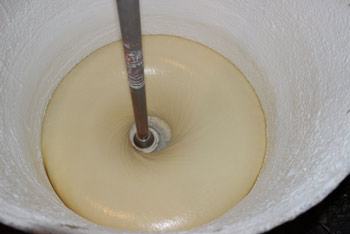
First bag of white pigment added to oil resin for a white oil semi-gloss mix. The decision to add the next ingredient is based on how the churning paint looks as it responds to the adjustable spinning mixer blade. Fishermen’s Voice photo
“We have not yet unpacked all the business and personal documents and memorabilia that we packed in 1969 and moved to the new location,” said George IV recently. His ancestors saved everything, he said. “Everything” included letters to and from customers, compliments from customers delighted with the look of their boat after painting with Kirby paint, bills, business cards, early paint can labels and photographs, filling many boxes in the second-floor office. That office is effectively the museum archive of what might be oldest surviving and active custom small-batch marine paint manufacturer in the United States.
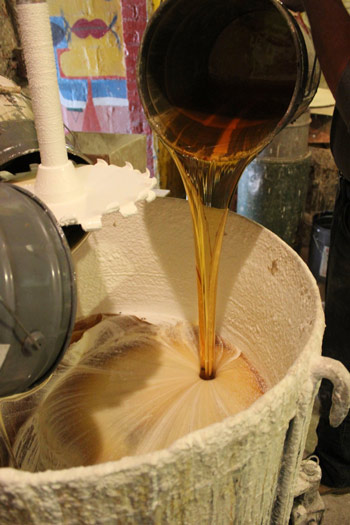
With the mixing blade raised, more gallons of oil resin is added. It will be blended in before the next 50-pound bag of pigment is added and blended in. The surface characteristics of the mix are examined for texture, smoothness, shine and body while the blade churns the growing volume of the batch. Fishermen’s Voice photo
Until George Kirby III was born, most of the fishing boats in New Bedford and southeastern New England were built with wood. Today most fishing boats are fiberglass or steel. Formulated for use on wood, Kirby paint can be used on fiberglass. Kirby paint was used to paint the Charles Morgan when it was restored at the Mystic Seaport Museum in Mystic, Conn., in the 1970s.
George IV said, “When someone calls to say their boat looks great [with a new coat of Kirby paint], it is part of the reason I do this. Pleasing customers is a part of it.”
Kirby is a painter’s paint. The ability of the paint to be carried by the brush, flow well from the brush, have good leveling qualities, cover well the existing surface color, leave a wet edge for the next pass to blend into, dry hard but flexibly, and result in a particular sheen that is neither gloss nor flat are some of its excellent characteristics. It has a particular sheen for which Kirby is known among painters. These characteristics are created by the quality of the ingredients and the skill of the paint maker who measures and mixes them.
Professional painters who demand a professional-looking result know it is more difficult and ultimately more expensive to work with low-quality paint. Professional results don’t come out of brand X cans because quality ingredients were not put in those cans. The additional time spent dealing with low-grade paint problems – drips, sags, streaks, extra coats, etc. – negates whatever price savings there might have been. The cost of paint, for either a new paint job or a repaint, is a relatively small part of the total job. Labor is typically the largest cost factor, particularly in prepping for a repaint. Another large cost is repainting again sooner if low-quality paint is used, because it will fade, crack, or peel more quickly than high-quality paint. Ultimately, good-quality paint costs less than low-quality paint.
Kirby Paint made house paint in 1846 and still does. They added a line of latex house paint in 2016.
Mixing a batch
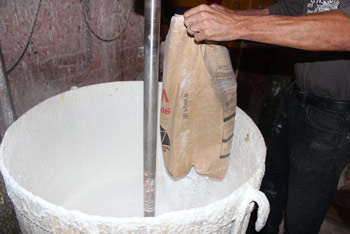
Three 50-lb bags of pigment, three 50-lb bags of thickener solids and 30 gallons of oil resin are added in twelve metered steps. Mineral spirits are added to adjust viscosity and three driers to control the rate the paint will dry. Fishermen’s Voice photo
Mixing a batch of paint is a two-part process. The first part ends with half the ingredients added and blended in sequence to the satisfaction of the paint maker. The batch begins with five gallons of oil resin and 50lbs of powdered pigment. After the mixer blade has blended these the sequence is repeated twice. During each sequence the vat is shifted around horizontally and vertically while the blade is spinning to ensure the batch is thoroughly mixed. The action of the mixer blade heats up the batch. The degree of warming is monitored. “When it gets to a certain temperature, I know from experience it is warm enough,” said Kirby. After the last warming, it is left to rest and cool down.
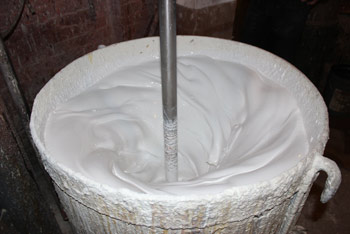
Part two of the mix follows a similar sequence, but oil resins are followed with solids rather than pigments to build body in the paint. Mineral spirits are gradually added, from a quart up to five gallons at a time. Pictured is the last of mixing of the finished batch. Fishermen’s Voice photo
When adequately cooled, the second round of alternating oil resins, solids, mineral spirits, dryers and heating and cooling begins. In the second part of the process, Kirby adds a 50-pound bag of solids that he calls his secret ingredient. Kirby watches the surface almost continuously, looking for changing characteristics that only an experienced paint maker can see and understand. He says changes in the paint’s viscosity are visible. These changes indicate when the batch is ready for the addition of another ingredient. The churning surface of the paint can appear to have a coarse, granular surface or a smooth, shiny surface as viscosity and degree of completion progresses.
Toward the middle of part two of the mixing process, dryers are added one at a time. Calcium, cobalt and zirconium dryers are blended in and an anti-skinning agent follows. The speed of the blender blade is adjusted and the temperature of the batch is monitored by placing the palm of a hand on the lower side of the vat. When all the ingredients have been added and the batch mixed, Kirby watches the surface change, waiting for the look of a finished batch of paint.
He pours mineral spirits into a one-quart metal pouring can. Holding the handle, he carefully adds a few ounces to the churning 62-gallon mix and watches the reaction of the batch. A few minutes pass as he watches. He adds a few more ounces of spirits, watching the viscosity respond to the spinning mixer blade. After a while, he puts down the pouring can with the remaining spirits in it, says “its done,” switches off the vat and leaves the mixing room.
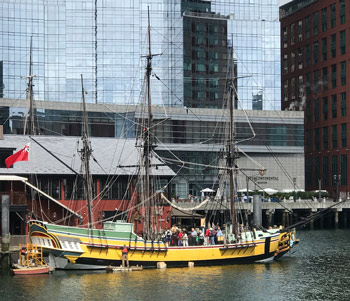
The original Eleanor was one of several vessels owned by a leading colonial Boston merchant, John Rowe, whose holdings included stores, warehouses and Rowe’s Wharf, a current Boston landmark. No original plans exist of the Eleanor. However, it is known from her tonnage figure, as recorded in shipping papers, that she was full rigged and a “constant trader.” The design of the Eleanor replica is based on colonial merchant vessels of the period that fit her description, particularly the London, a ship that carried part of the same shipment of tea to Charleston, South Carolina. The London was later sold to The Royal Navy. Carefully measured line drawings were recorded and preserved which were very helpful in creating a set of plans for the Eleanor. Kirby’s Marine paints were used to paint The Eleanor. The Eleanor is tied up at the Boston Tea Party Museum at 232 Congress St., Boston, MA.
A little under two hours earlier the process began—a process older than Kirby Paint. “I would bet I’m the smallest batch paint manufacturer in the country,” said Kirby. That’s a scale, like craft beer, that calls for careful monitoring, the use of quality ingredients and the application of skills essential to manufacture a product to the highest known standards. “We use quality ingredients. We don’t skimp on ingredients,” said Kirby. “Our name is on the can.”
When the batch has cooled, the paint will be poured through a filter into gallon cans. The cans will be sealed, labeled and marked.
The paint making process has been handed down in the Kirby family from generation to generation. George said he takes great pride in this tradition. “People send in paint samples and paint chips for us to match. We do it by eye,” he said. Generational family traditions like this were common in Europe and the United States before industrial mass production. Violin makers, sculptors, musicians, bakers, horse tack makers, thatchers and boat builders had the knowledge and pride in mastery passed down to them.
For the last decade or so, there has been a move to revive skills used to make quality beer, bread, wooden boats and food. The prefix “artisanal” is added to indicate hand-crafted and quality ingredients. Kirby Paint never stopped making quality paint. George Kirby IV’s grandfather was asked in the 1970s how, without even advertising or having a salesman, so many people continued to buy their paint. George Kirby III said, “It just works, that’s all.”
